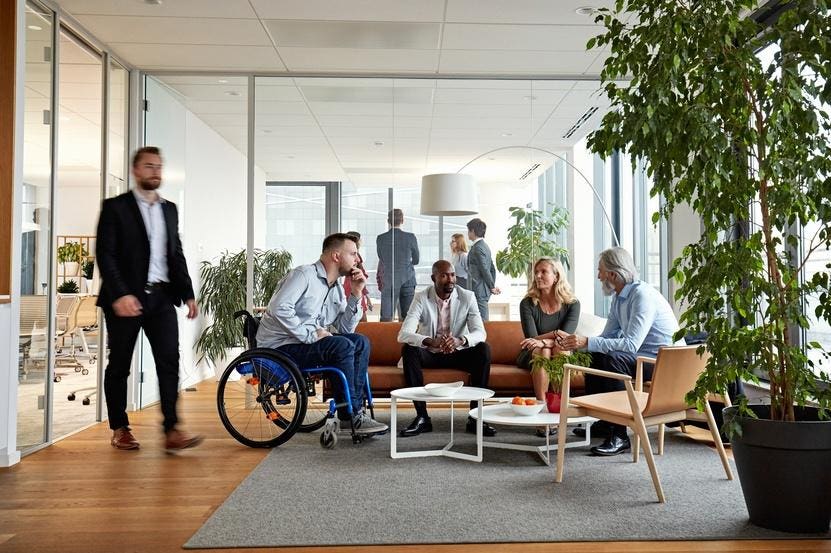Business associates in their 20s, 40s and 50s relax in the modern lounge and exchange ideas. [+] office.
Getty
Disabilities affect one in four people in the United States and abroad. Growing workforce shortages create an opportunity to be more inclusive of people with disabilities who have historically been left out of the workforce. To be more inclusive, practice inclusive behaviors every day, change the language you use, be respectful and curious, and be an advocate for the long term.
The CDC estimates that approximately 61 million people, or one in four (26%), living in the U.S. community are affected by a disability. Worldwide, more than one billion people are affected by a disability. Only 21% of people with disabilities are employed in the U.S., but this number has been increasing in recent years, primarily due to the growing popularity of remote work.
With labor shortages becoming more severe and predicted to continue, this is a clear opportunity to make the workplace more inclusive of people with disabilities — not a nice-to-have, but a necessity — and a competitive differentiator in attracting and retaining talent.
We know that making the workplace more disability-friendly makes it easier for everyone. This is best illustrated by the curb-cut effect: making sidewalks more disability-accessible benefits all of us, not just the people we originally targeted: people with strollers, people on bikes, seniors, people with mobility issues.
Many types of disabilities are not visible and are sometimes called “invisible” disabilities. Common examples of disabilities include:
Physical disability Mental disability Speech disability Medical disability Learning disability Hearing loss Visual impairment Brain injury Attention deficit disorder
It is also important to note that the CDC includes mental health and neurodiversity under the concept of disability. Mental health is different from neurodiversity. Examples of mental health include:
Depression Bipolar disorder Anxiety
Neurodiversity means that a person’s brain works differently than most other people’s – verbally or non-verbally. Some common (but not exhaustive) forms of neurodiversity include:
ADHD Autism Asperger Syndrome
To become more inclusive, we encourage you to practice inclusive behaviors on a daily basis, change your language, be respectful and curious, and continue to advocate for others in the long term.
Practice inclusive behaviors every day
Everyday acts of inclusion matter. It’s these everyday actions that you’ll often be measured against as an inclusive leader — taking action. Consider these ideas to support people with disabilities:
Adjusting working hours and office layout Introducing specialized equipment to meet needs Introducing interpretation and subtitles for the visually and hearing impaired
If you don’t know what someone likes, ask, respectfully of course. Here are some example questions to ask:
How can we make our workplace more inclusive for people with disabilities? What can I do to be more inclusive of people with disabilities? What conversations do we need to have about disability inclusion that aren’t currently happening?
Change Language
It’s important to remember that everyone has their own preferences for how they want to be described or referred to. Before you ask someone what their preferences are, listen, learn, and build trust first. It’s often helpful to look for clues in their words and mimic their descriptions of their identity when describing them.
To be more inclusive of people with disabilities in the workplace, consider using human-centered language that acknowledges a person beyond their current condition and sees their full identity rather than limiting them to their disability. Consider subtle changes in your language, such as:
Say “people with disabilities” instead of “people with disabilities” Say “healthy people” instead of “healthy people” Say “people with autism” instead of “people with autism”
Being inclusive doesn’t require a complete overhaul of the language you use, but it does require some changes. Consider making these adjustments:
Unrealistic (not insane) Unbelievable (not crazy) Nasty (not psycho) Terrible (not stupid) Bad (not stupid) Bizarre (not psycho) Limited (not disabled) Orderly (not OCD) Accessible (not disability-friendly) Ridiculous (not retarded) Moody (not bipolar)
Be respectful and curious
We don’t want to put the responsibility of educating the majority on people with disabilities. Instead, research what you don’t already understand, find reliable sources, and ask educated questions of people who may be living with disabilities. They may be able to provide more context from their own experiences that will verify or refute what you have already researched. We don’t want to place the brunt of education on other people who have already experienced the adversities of diversity.
Maintaining alliances
Allyship is perceived in the eye of the beholder and is not something to declare lightly. Allyship is best demonstrated through actions rather than calling yourself an ally. If you are striving or hoping to be a better ally, consider the following ideas:
Investigate the inclusivity of your workplace and ask for accommodations Explain the “disincentive effect” to people to increase support within your organisation Engage in open conversations with curiosity and show your support Volunteer with organisations that support people with disabilities Expand your network and learn from people with disabilities
Disability impacts many of your potential workforce. Growing workforce shortages create an opportunity to be more inclusive of people with disabilities who have historically been left out of the workforce. To be more inclusive, practice inclusive behaviors on a daily basis, change the language you use, be respectful and curious, and commit to long-term advocacy.

